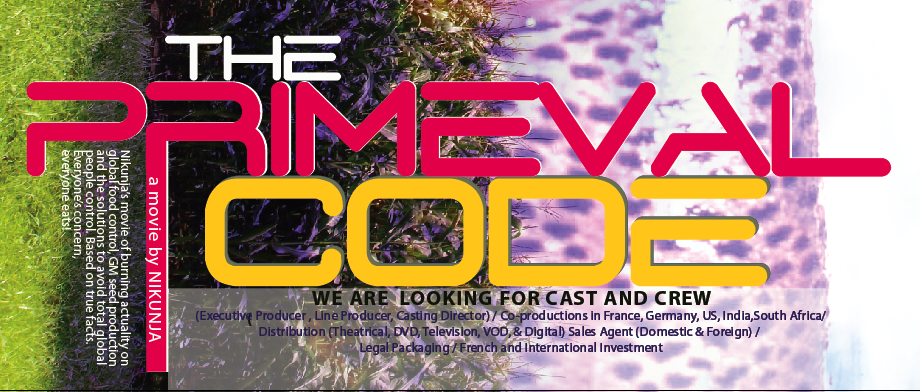The movie opens on a mid aged Indian farmer, slowly closing the door of the shabby hut, a last look on his wife and kids. A bottle of Pesticide by SAMTO will serve him to escape the consequences of another failed crop and his hopeless financial situation, like thousands of farmers the world over.
The laboratory of BEAT FERRER, German research scientist in Berlin. His artist son LINUS is fascinated by his latest bio physical discovery: the revitalisation of the evolutionary memory in organisms. The beauty of science, the mystery of evolutionary life unveiled. But not only this.
20 years later. In LINUS’ Berlin warehouse artist studio, Linus, in his 40ties, the suit tells his artistic breakthrough somewhere in the past 20 years, meets with his scientist brother HANNES, just one year younger than him, his friend, African ex revolutionary RASMIN OUEDRAOGO for an interview with the Face of Africa beauty, afro-american snbc TV journalist MIRIAM LOGHAN. She researches about the confrontation between multinational US based corporation SAMTO and the BEAT FERRER FOUNDATION created by the three. That’s where the audience learns about the geo political fight for food control, as a means to dominate world population, a theme everyone has heard of, everyone is concerned with. And the Ferrer-discovery offers a solution, enabling modified GM plants to recover their natural state, and strengthening degenerated normal plants and fish, making them immune against contemporary pests and parasites. The Ferrer Brothers, according to Linus’ ideal, want to distribute the method on a non for profit basis, thus to undergo the geo-political struggle for global food control as global people control.
Miriam returns to her home in New York and establishes a relationship with SAMTO CEO MAXWELL ANDERSON, first to get access to information about SAMTO’s true hidden strategies.
Anderson, handsome in his 50ties, is attracted to Miriam by her mystical beauty and her insight into the arts, himself a passionate art collector, a kind of escape of his most successful social status and the corporate system, which he feels more and more encaging. Miriam’s spiritual approach to sexuality binds him fully.
SAMTO’s main strategist, boardmember SAMUEL HARRINGTON, is only keen to take Anderson’s position, and is lobbying with Secretary of State NEIL GREENSPAN, developing strategies to stop the evolution of BF Foundation.
Miriam, on a research trip together with BFF members Hannes and Rasmin, experiences the true power of SAMTO when she is put in the terrible City jail in Ouagadougou, due to the BFF experimental cotton plantations in the South of Burkina Faso, declared Illegal. They can only escape in a staged escape, arranged by Rasmin’s father and Mossi King KANGO. But before this incident, Miriam in a mixture of utter fascination by the African surrounding and self-forgetfulness gives herself genuinely to Hannes.
Returning to N.Y. depressed and shocked, Miriam’s relation to Anderson is in crisis and an important exchange takes place in Anderson’s luxurious weekend bungalow at the seaside, which influences Anderson’s future actions.
While Harrington hardens his multiple actions against BFF buy inspiring the bio terrorist group GOLDEN LEAF , set up by former CIA agent ANDRE LACOSTE, BFF’s Rasmin starts his presidential campaign in Burkina Faso, to escape Lacoste’s malicious trap.
Linus, the idealistic president of BFF spoils the negociations between SAMTO and BFF during a video conference, initiated by Maxwell Anderson. An important phone call between him and Anderson follows.
Linus is being assassinated in a staged car accident. Discovering the truth about the commanders of the murder, Anderson leaves SAMTO. He joins Hannes in Berlin, escaping only short a murder attempt on himself, while riding to JFK.
Miriam, which also travels to Berlin, has to navigate her triangle affair with Hannes and Anderson. Anderson will finally join Rasmin’s presidential campaign in Africa and support strategically BFF.
Harrington orders the kidnapping of Miriam to pressure Hannes to resign from BFF activities.
Anderson, knowing by Rasmin about Miriam’s relation to Hannes, joins him anyway to support his negotiations with the kidnappers forMiriam’s liberation. Again he has to surpass himself, like earlier in the story.
An undercover action by German BKA agent and Rasmin’s revolutionary Arab friends leads to Miriam’s liberation in a tough shoot out action.
Anderson and Hannes meet at Miriam’s hospital bed after her liberation. She loves both and has to take a decision.
Rasmin wins the selection in Burkina and assures a new beginning for BFF. JEAN GAUTIER, director of the World Food program at the UN and Rasmin’s friend from Sankara times, wins the legal battle against a resolution which would have forbidden plantations outside of the government controlled multinational corporation system, a resolution brought in by the US government.
The BFF future is further on assured by the support of the new government in Burkina Faso. BFF creates a first model of how to deal with important scientific knowledge, which can benefit a majority of people. How to free people from hunger, instead of attaching them to corporate and geopolitical interests.
And then, at its best, a model for a citizen based political structure. The Primeval Code as the reversed Pyramid. To renew a system, go to its origin.
In his own logic, writer director Nikunja carries the very meaning of “shared authority” into his own cinematographic creation, involving the spectator’s authority into the perception process of the movie, thus returning to him a responsibility lost in the “audience as slave” attitude. Taking Tarkovsky to heart, Nikunja conveys content by stimulating the spectator’s associative intuitive plane and achieve a cinema formulation, which creates content through subjective psychic perception.
|
|
Coming from painting and visual arts I take a new approach to cinematographic work. The materiality of the format in which we shoot in, lets say 35mm, different HD formats, dv formats, etc I use as a psychic texture in the formulation of the cinema work, as you would use different textures in painting for expression. This materiality does not have to appear in a “narrative logic” as it is seen commonly in new cinema, but as a value of expression in itself. I give a texture to the movie surface and compose it as a significant structure in regards to the artistic content of the movie.
In a similar way I treat the quality of performance. Working also in art performances, contemporary dance, ritual performance, I use those “performance materials” as textures, confronting the regular acting, and touching a level of authenticity, which otherwise hardly appears. This approach demands an extensive preparation with the individual actors and a precise choice during casting, which is not merely focussed on the acting performance but on the psychic structure of the personality of the candidate. This preparation is very individual and then directed to the important aspects of the character.
During the actual shooting phase, there are rarely scenes being shot twice or more times. I work in performance sequences, to which the participating actors are prepared, so that they know precisely the content to achieve but keep a free approach to the interpretation of that aspect. It is very performative and the actors are forced to be totally integrated in the sequence, for there are no two takes. Everything is being shot with several cameras at the same time and with several formats at the same time.
The editor phase of the creation process becomes a very exciting phase, for here I can finally compose the movie, in the sense like a painting in multiple layers. This creates an approach to representation, which allows to the spectator to choose different angles of views and to become a creative element while watching. I try to give an authority to the spectator, basically an authority of choice. The hypnotic power of the projected image, sometimes I would break, so that another rhythmical sensation can take place and the spectator finds himself for a moment, giving him a chance to situate himself inside of his own psychic cinematographic experience. Thus the time factor is very important in the editing phase.
By these means I am creating a new cinematographic language which is dense, but also direct and simple in the sense, that it approaches the psychic sensations and later only the intellectual plane. To me it is important to create an art piece, which can communicate to anyone, of any origin, at a mere human level.
Nikunja


|

